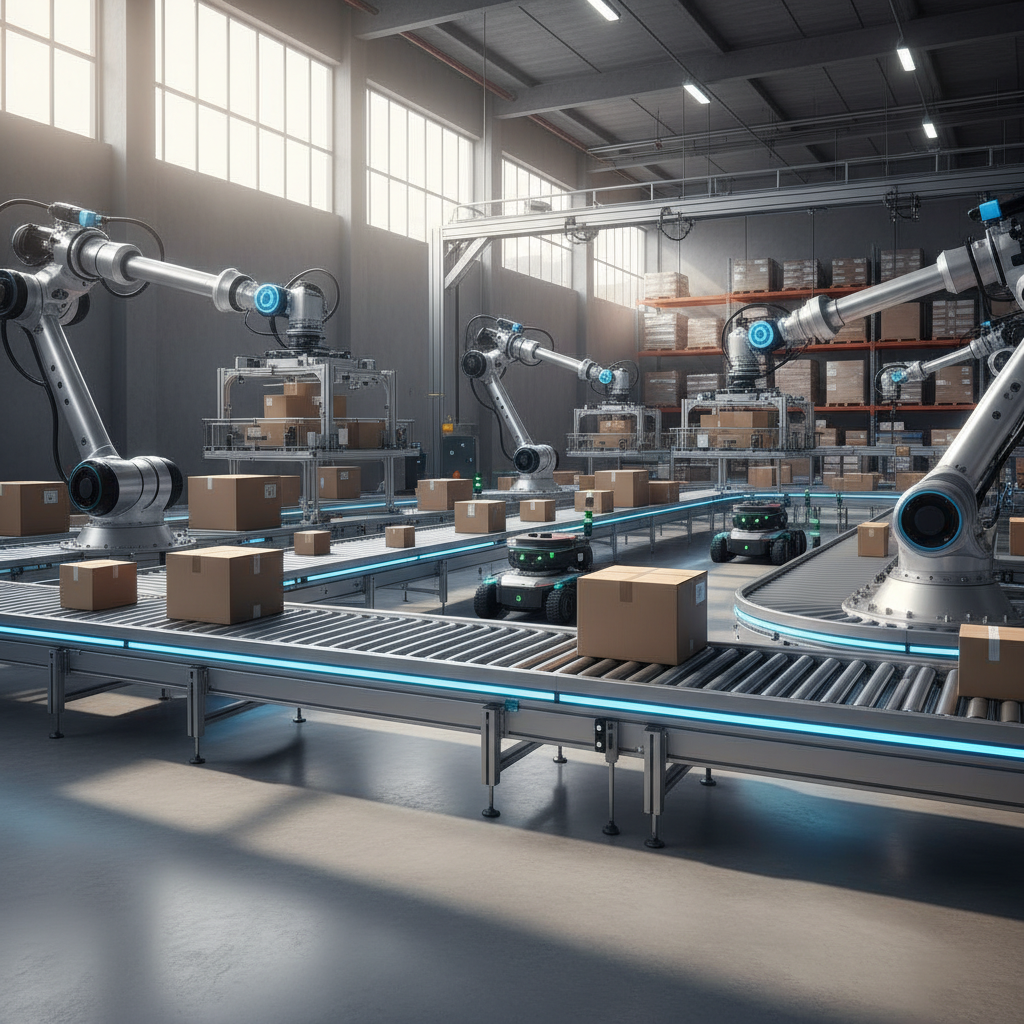
Table of Contents
Introduction
In today’s fast-paced global economy, supply chains are more complex and demanding than ever before. Imagine a business striving to deliver products seamlessly across continents while facing fluctuating demands, rising costs, and unexpected disruptions. How can companies stay competitive in such a challenging environment? The answer lies in harnessing cutting-edge technology that is revolutionizing supply chain management. By leveraging innovations from automation to artificial intelligence, businesses are transforming traditional supply chains into agile, transparent, and efficient networks.
Technology’s impact on supply chain management cannot be overstated. As supply chains stretch across multiple players—suppliers, manufacturers, distributors, and retailers—the need to streamline operations and maintain visibility becomes paramount. A recent study highlights that over 70% of companies adopting advanced supply chain technologies report significant improvements in delivery times and customer satisfaction. This transformation is not just a trend but a necessity for survival in today’s competitive market. From inventory management systems to real-time logistics tracking, technology empowers businesses to anticipate challenges and respond proactively, minimizing costly delays and errors.
At the heart of this technological revolution are innovations like automation, data analytics, and connected devices that enhance every link in the supply chain. Consider the power of robotic automation in warehouses, which accelerates order fulfillment while reducing human error. Or the role of artificial intelligence, which uses predictive analytics to forecast demand with unprecedented accuracy, helping companies optimize stock levels and reduce waste. These advancements not only improve operational efficiency but also foster stronger collaboration among supply chain partners through enhanced data sharing and real-time communication platforms.
Understanding the broader technological landscape is essential for grasping how these tools reshape supply chains. If you’re interested in the broader impact of emerging technologies, exploring the latest technology trends of 2025 offers a comprehensive look at innovations like AI, IoT, and robotics that are redefining industries globally. Additionally, deep dives into technology and artificial intelligence provide valuable insights into leveraging AI ethically and effectively, a key to unlocking supply chain potential.
What You’ll Learn in This Guide
This guide provides a thorough exploration of how technology is reshaping supply chain management. Whether you are a business leader, supply chain professional, or an enthusiast, you’ll gain practical knowledge and strategic insights that can help you adapt and thrive in this evolving landscape. Here’s what to expect:
- Understanding the Role of Technology: We break down how essential technologies improve supply chain operations, from inventory control to demand forecasting, highlighting their tangible impacts.
- Exploring Key Technologies: Dive into the specific tools and innovations such as automation, robotics, AI, Internet of Things (IoT), and blockchain that are transforming supply chains today.
- Recognizing Benefits and Challenges: Learn about the advantages technology offers—including increased efficiency and cost savings—as well as the hurdles companies face like integration issues and skills shortages.
- Discovering Future Trends: Stay ahead with a look at emerging technologies poised to shape supply chains in the coming years, including advancements in AI, expanded IoT networks, and blockchain applications.
As we journey through this comprehensive guide, each section will elaborate on these topics with real-world examples, expert insights, and actionable advice. This knowledge will equip you to make informed decisions about adopting and leveraging technology within your own supply chain operations. By understanding these dynamics, you’ll be better prepared to enhance productivity, reduce risks, and create value throughout the supply chain.
The article will begin by defining the critical role technology plays in today’s supply chains, spotlighting how it supports key functions that businesses rely on every day. We will then explore the innovative technologies currently reshaping the industry, demonstrating their unique contributions and integration approaches. From there, we address the measurable benefits organizations enjoy and the common challenges they face, providing balanced perspectives for realistic planning.
Finally, we look ahead to future trends, arming you with knowledge about cutting-edge developments that promise to revolutionize supply chain management even further. With this holistic view, you’ll have a strategic roadmap to navigate the technological evolution shaping business success. Let’s dive in and discover how technology is fundamentally transforming supply chains and what that means for you and the future of your business.

Technology has become a cornerstone of modern supply chain management, revolutionizing how businesses operate and compete in today’s fast-paced, global market. As companies face increasing demands for speed, accuracy, and transparency, integrating advanced technology solutions is no longer optional but essential. From improving inventory accuracy to facilitating real-time collaboration, technology empowers supply chains to be more agile and responsive. This discussion delves deeply into how technology impacts supply chain management, exploring its key roles, types, benefits, and the challenges organizations encounter in adopting these tools effectively.
The Role of Technology in Supply Chain Management
Technology plays a critical role in enhancing supply chain efficiency and visibility, offering businesses the tools to streamline operations, reduce costs, and better meet customer expectations. Modern supply chains rely on a range of technology-enabled processes that allow for accurate tracking, faster decision-making, and improved coordination among stakeholders. With the vast amount of data generated along the supply chain, technology enables actionable insights through analytics and automated systems, facilitating smoother workflows and error reduction. At the core, technological adoption supports the synchronization of complex activities from sourcing raw materials to delivering finished goods.
Moreover, technology enhances collaboration by providing integrated platforms that connect suppliers, manufacturers, logistics providers, and retailers. These platforms foster transparency and real-time communication, essential for managing disruptions and adapting to market changes quickly. As global commerce becomes more intricate, embracing technology becomes indispensable for maintaining competitive advantage and ensuring operational resilience.
Key Aspects of Technology in Supply Chain Management
The impact of technology across various supply chain functions is considerable. To appreciate its full potential, consider the following key areas where it drives transformation:
- Inventory Management: Automated inventory systems use real-time data to track stock levels, preventing overstocking or stockouts. Accurate inventory management helps optimize warehouse space and improves cash flow by reducing unnecessary inventory holding costs.
- Order Processing: Technology streamlines order handling from placement to fulfillment using electronic data interchange (EDI) and automated workflows. This decreases processing times, reduces human error, and enhances customer satisfaction through timely deliveries.
- Logistics and Transportation: Route optimization software, GPS tracking, and transportation management systems (TMS) improve delivery efficiency and reduce fuel consumption. Real-time tracking enhances the visibility of goods in transit, mitigating delays and providing accurate estimated arrival times.
- Demand Forecasting: Advanced analytics and machine learning algorithms analyze historical data and market trends to predict customer demand accurately. Better forecasting leads to more efficient production scheduling and inventory planning, minimizing costs associated with excess or insufficient stock.
Types of Technology Used in Supply Chain Management
Today’s supply chains benefit from a diverse array of innovative technologies, each addressing specific operational challenges and enhancing overall performance. Understanding these technologies helps organizations select the right tools aligned with their strategic goals. The integration of these technologies forms the backbone of a smart, connected supply chain built for agility and transparency.
Among these, automation, data analytics, IoT, and blockchain stand out as transformative forces reshaping traditional supply chain models. Leveraging these technologies enables proactive management and continuity in the face of evolving market demands and disruptions. Organizations continuously explore and adopt new solutions to stay ahead in an increasingly competitive landscape.
Important Considerations for Technology Types
Key categories of technology that drive supply chain innovation include:
- Automation and Robotics: Warehouse automation technologies like conveyor belts, automated guided vehicles (AGVs), and robotic arms enhance picking, packing, and sorting processes, reducing manual labor and increasing accuracy. Robotic process automation (RPA) helps automate repetitive administrative tasks such as invoicing and report generation, increasing operational efficiency.
- Data Analytics and Artificial Intelligence: Predictive analytics analyze large datasets to forecast demand patterns and identify potential supply chain risks. AI-driven decision-making supports dynamic pricing, inventory optimization, and route planning, enabling more informed and agile responses to changing conditions.
- Internet of Things (IoT) and Blockchain: IoT devices such as sensors track the condition and location of goods in real time, providing granular visibility into supply chain activities. Blockchain technology enhances security and transparency by creating immutable records of transactions, facilitating trust among supply chain partners and preventing fraud or counterfeit goods.

Conclusion
Technology has unquestionably become the linchpin in modern supply chain management, driving transformative changes across how businesses operate in today’s fast-paced, global market. This article explored the critical role that cutting-edge technologies play in enhancing key supply chain functions such as inventory management, order processing, logistics, and demand forecasting. These technological advancements empower businesses to improve speed and accuracy while increasing transparency throughout the supply chain network, thus enabling better decision-making and streamlined operations.
We examined a variety of pivotal technologies reshaping supply chains today, including automation and robotics, which accelerate warehouse processes and reduce human error; data analytics and artificial intelligence, which turn vast data into actionable insights that optimize inventory levels and anticipate demand shifts; and the Internet of Things (IoT) alongside blockchain, which enable real-time tracking and enhance security and trust among supply chain partners. The integration of these technologies fosters an interconnected, collaborative environment where stakeholders can communicate instantly and respond proactively to disruptions or market changes.
However, adopting innovative technology is not without challenges. Organizations often face significant initial investments required for acquiring and integrating these advanced tools within existing systems. Compatibility issues and data silos can hinder seamless operational flow, while continuous training and a shortage of skilled personnel are ongoing hurdles in maintaining and maximizing technology benefits. Despite these obstacles, the tangible benefits such as increased efficiency, cost reductions, and improved visibility make technology adoption vital for businesses aiming to stay competitive.
To harness these benefits effectively, businesses should prioritize a strategic approach to technology adoption. Begin by assessing supply chain needs and selecting technologies aligned with organizational goals and operational challenges. Investing in scalable, integrated platforms can alleviate many integration headaches and foster better collaboration across the supply chain. Additionally, developing training programs to upskill teams ensures that personnel can maximize new technology capabilities confidently and efficiently. By following these actionable steps, businesses will be well-positioned to transform their supply chains into agile, resilient, and transparent networks.
Looking ahead, emerging trends indicate that supply chain technology will continue evolving rapidly. Advanced artificial intelligence and machine learning are poised to enhance predictive capabilities and enable autonomous, self-optimizing supply chain operations. Expansion of IoT networks will offer more connected devices for granular, real-time asset management, while blockchain technology promises improved traceability, security, and implementation of smart contracts. Staying informed about these advancements and strategically integrating them will keep businesses ahead in a competitive, dynamic market.
For those interested in deepening their understanding, exploring the latest technology trends of 2025 offers broad insights into innovations like AI, IoT, and robotics that are redefining industries globally. Additionally, a comprehensive overview of technology and artificial intelligence provides valuable perspectives on leveraging AI ethically and effectively. To further grasp the power of data in supply chains, consider learning more about technology and big data and the impactful role it plays in analytics and decision-making. Lastly, understanding artificial intelligence trends for 2025 will prepare businesses for upcoming AI-driven transformations in supply chain management.
Embracing technology in supply chain management is no longer an option but a necessity. By leveraging these advanced tools thoughtfully and strategically, companies can unlock new levels of efficiency, transparency, and resilience that will define business success for years to come. Stay curious, stay adaptable, and let technology propel your supply chain into the future.
Frequently Asked Questions
-
What is supply chain technology?
- Supply chain technology refers to the tools and systems used to enhance supply chain operations, from tracking inventory to automating workflows and enabling data-driven decisions.
-
How does technology improve supply chain efficiency?
- Technology automates tasks, improves data accuracy, and facilitates real-time communication, making supply chains faster, more accurate, and responsive to market changes.
-
What are common challenges in adopting supply chain technology?
- Common challenges include high initial costs, difficulties in integrating new technologies with legacy systems, and the need for ongoing training and skilled personnel.
